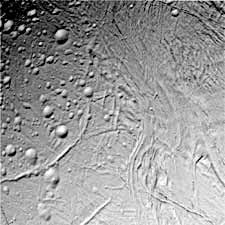Saturn II
Enceladus (“en SEL a dus”) is the eighth of Saturn’s known satellites:
orbit: 238,020 km from Saturn
diameter: 498 km
mass: 7.30e19 kg
In Greek mythology Enceladus was a Titan who was defeated in battle and buried under Mount Etna by Athena.
Discovered in 1789 by Herschel.

Craters and smooth plains
Enceladus has the highest albedo (>0.9) of any body in the solar system. Its surface is dominated by fresh, clean ice.
At least five different types of terrain have been identified on Enceladus. In addition to craters there are smooth plains and extensive linear cracks and ridges. At least some of the surface is relatively young, probably less than 100 million years.
This means that Enceladus must have been active until very recently (and perhaps is still active today). Perhaps some sort of “water volcanism” is at work.
Enceladus is much too small to be heated solely by the decay of radioactive material in its interior at present. But briefly after its formation 4.5 billion years ago short-lived radioisotopes may have provided enough heat to melt and differentiate the interior. That combined with modest present day heating from long-lived isotopes and tidal heating may account for the present day activity on Enceladus.

Cassini closeup view (looks like Europa?)
Enceladus is locked in a 1:2 resonance with Dione (similar to the situation between Io and Europa). This may provide a heating mechanism but it is probably insufficient to melt water ice. Enceladus may therefore be composed of some low-melting point material rather than pure water.
Enceladus is very likely the source of the material in Saturn’s tenuous E ring. And since the material cannot persist in the ring for more than a few thousand years, it must be due to very recent activity on Enceladus. A less likely possibility is that the rings are maintained by high-velocity collisions between dust particles and the various moons.
More about Enceladus
- more images
- Cassini continues to investigate …
Open Issues
- What is the resurfacing mechanism? where does the energy come from?
- Is there a liquid layer beneath the surface?
